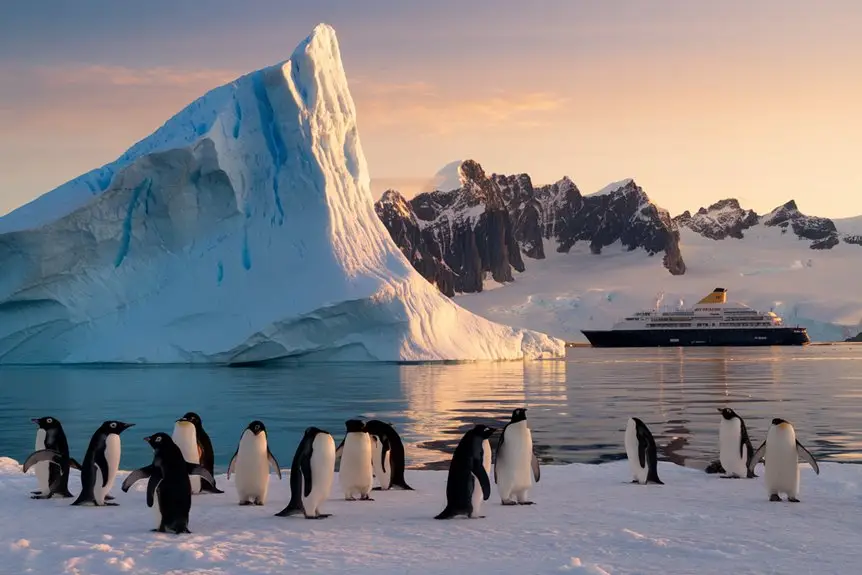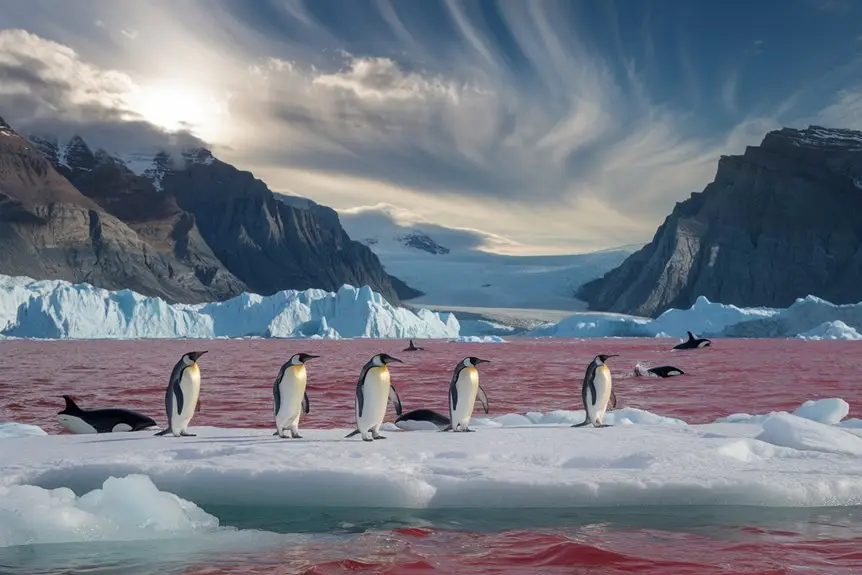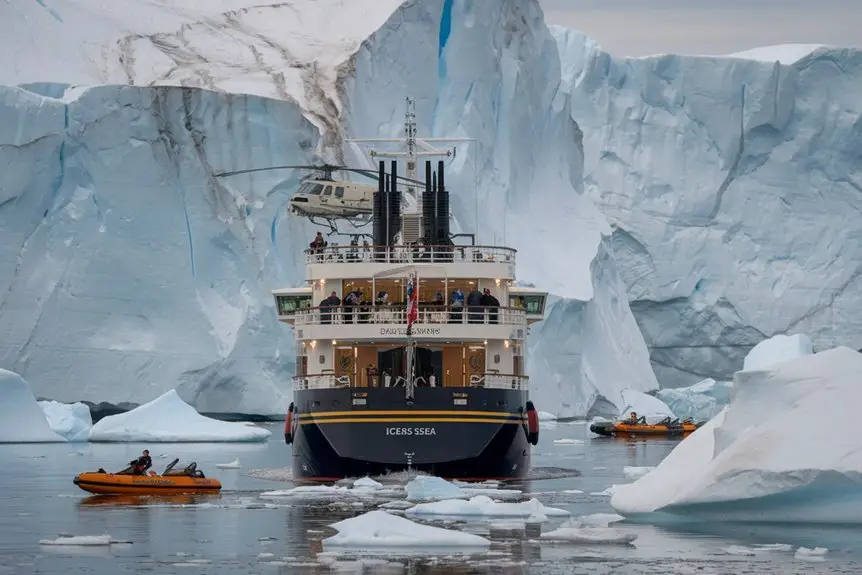Experience the Ross Sea’s incredible marine life on your Antarctic adventure, with trips running in January and February. You’ll enjoy up to 20 hours of daylight during these peak months. The journey takes 22-35 days from New Zealand or Australia, letting you spot Emperor penguins, humpback whales and the massive Ross Ice Shelf up close.
For other Antarctic Cruise destinations check out our Antarctic Cruise Destinations Guide page.
You can pick from different ships to match your travel style. The cosy Akademik Shokalskiy carries 48 passengers, while the Scenic Eclipse offers luxury travel with your own butler. Prices begin at £15,400.
Your trip includes exploring Earth’s biggest marine reserve and viewing active volcanoes. The Ross Sea gives you a unique chance to see Antarctica’s most diverse marine ecosystem in action.
🐧 Polar Cruise Enquiry 🐻❄️
Our team of polar travel specialists have personally explored both the Arctic and Antarctic regions – from tracking polar bears in Svalbard to kayaking with penguins off the Antarctic Peninsula. Let us find the right polar expedition cruise for you.
Key Takeaways
You’ll find the best Ross Sea cruising during January and February:
- January offers calmer waters
- February gives you prime whale watching
Your cruise options:
- Departure points: New Zealand or Australia
- Journey length: 22-35 days
- Cost: £15,400 to £54,500
Your vessel choices:
- Ice-strengthened adventure ships
- Luxury ships like Scenic Eclipse, where you get butler service
You can spot these animals:
- Humpback whales
- Orcas
- Adélie penguins
- Emperor penguins
- Various sea creatures
The Ross Sea gives you:
- The world’s biggest marine protected area
- Historic sites from early polar explorers
- Views of McMurdo Station, a working research base
What Makes Ross Sea Special

The Ross Sea sits at Antarctica’s southern edge, marking one of Earth’s most important marine environments. You can explore McMurdo Station, the continent’s primary research facility, or visit historic buildings including the first-ever Antarctic structure at Cape Adare, plus famous explorer huts from Scott and Shackleton’s journeys.
The marine ecosystem makes this region extraordinary. You can observe vast colonies of Adélie penguins nesting at Cape Adare, whilst seals, whales and seabirds feed in the nutrient-rich waters.
The landscape showcases three major features: the enormous Ross Ice Shelf, the active Mount Erebus volcano, and distinctive rock formations.
The Ross Sea now holds protected status as Earth’s largest marine reserve, covering 1.55 million square kilometres. This designation safeguards crucial habitats for countless species and helps maintain the area’s pristine condition.
The waters here rank among the most productive on the planet, supporting a remarkable food chain from microscopic plankton to large marine mammals.
You’ll find this region offers unmatched opportunities to witness Antarctic wildlife in their natural habitat.
When to Take Your Cruise

The best time for your Ross Sea cruise is January or February. These months give you the clearest access through melted ice and the warmest temperatures in Antarctica.
Your wildlife experiences will vary by month:
- January offers calm seas and warm weather
- February brings more whale watching opportunities
You’ll get up to 20 hours of daylight during these peak months, making your exploration time longer and more worthwhile. The weather can change quickly, so your landing spots will be decided on the day.
Choose peak season for the fullest experience, even though late-season trips might cost less. You’ll miss key wildlife moments if you travel outside the main months.
Tips for booking:
- Book January for the most stable conditions
- Choose February for whale watching
- Expect flexible itineraries
- Plan for variable temperatures
- Pack for unpredictable weather
Your cruise timeline directly affects what you’ll see and do in Antarctica, so timing matters for your adventure.
Essential Cruise Planning Tips

Planning Your Ross Sea Cruise
You need to check these key elements when choosing your cruise.
Time and Location
- Trip length varies from 22 to 35 days
- Ships depart from New Zealand or Australia
- January and February offer the best sea conditions
Vessel Selection
- Ice-strengthened ships suit adventure seekers
- Luxury vessels provide premium comfort
- Check passenger numbers to gauge crowd levels
Costs and Inclusions
- Prices start at £15,400 to £54,500
- Additional costs include activities and travel to ports
- Some packages cover accommodation and transfers
- Many cruises provide expedition gear
Essential Actions
- Book months ahead for peak season
- Review your guided excursion options
- Check your onboard facilities
- Compare different operators’ routes
Wildlife and Natural Wonders

The Ross Sea shows you Antarctica’s richest polar ecosystem right before your eyes.
You’ll spot humpback whales and orcas swimming through the nutrient-rich waters. Seals thrive here too, with 200,000 Ross seals and countless Weddell seals calling these waters home.
Two penguin species dominate the landscape. You’ll find 3 million Adélie penguins waddling across the ice, while 240,000 Emperor penguins gather in impressive colonies.
Look up, and you’ll see south polar skuas and snow petrels gliding through the Antarctic skies.
The underwater world proves just as spectacular. You can discover 95 different fish species, from Antarctic toothfish to colossal squid.
More than 1,000 types of invertebrates swim amongst seasonal plankton blooms, creating a thriving underwater community right beneath the surface.
See what’s on offer from the Falkland Islands Expedition Cruise for a different Antarctic Cruise destination.
Vessel Options and Amenities

You have three distinct vessels to choose from for your Ross Sea adventure.
The Ortelius:
- Carries 116 passengers
- Features two dining rooms
- Offers extensive deck space for wildlife spotting
- Ice-strengthened hull design
The Akademik Shokalskiy:
- Carries 48 passengers
- Includes a sauna and library
- Provides a more intimate experience
The Scenic Eclipse:
- Delivers 6-star luxury service
- Includes personal butler service
- Features custom stabilisers
- Provides polar boots and trekking poles
All vessels offer:
- Pre-cruise accommodation
- Transfer services
- Daily Zodiac excursions
- Expert lectures
- Polar-specific design
- Safe Antarctic navigation
Your choice depends on your preferred balance of luxury, group size and onboard facilities.
The Ortelius suits social travellers, the Akademik Shokalskiy works well for those seeking intimacy, and the Scenic Eclipse matches luxury preferences.
Frequently Asked Questions
What Medical Facilities and Staff Are Available on Ross Sea Cruise Ships?
Ross Sea cruise ships have a medical centre with a qualified doctor on board. You can visit the ship’s clinic for basic medical consultations at no extra cost. The facilities handle routine health issues and first aid, but have limitations. For any serious medical conditions, you’ll need evacuation to a mainland hospital.
Can Passengers With Mobility Issues Participate in Ross Sea Cruise Activities?
You can enjoy Ross Sea cruises with mobility issues, but you’ll need to plan carefully. Your ship will have accessible features like handrails and lifts. You’ll find crew members ready to help you move around safely. Weather plays a key role in which activities you can join. Zodiac landings require steady conditions and extra support from staff. You should discuss your specific needs with the cruise operator before booking to ensure suitable arrangements. Most ships offer alternative activities when landings aren’t possible for you.
How Reliable Is Internet and Phone Connectivity During the Cruise?
Internet and phone connectivity on cruise ships relies on satellite technology, which means you’ll experience varying service quality. You can access basic internet and make phone calls, but the service tends to be slower than land-based connections. Starlink-equipped ships offer faster speeds and better reliability than traditional satellite systems, but you should still expect occasional disruptions. Connection costs are typically higher than standard mobile rates, so you’ll want to check your cruise line’s pricing before sailing. Consider downloading content and setting up offline access to essential apps before your journey.
What Photography Equipment Is Recommended for Capturing the Ross Sea Experience?
Essential photography equipment for your Ross Sea adventure:
Your main camera:
- A DSLR or mirrorless camera with a full-frame sensor
- At least two camera batteries
- Waterproof camera housing or protective cover
Your lens kit:
- Standard zoom lens (24-70mm) for general shots
- Wide-angle lens (16-35mm) for seascapes and ice formations
- Telephoto lens (70-300mm) for penguins, seals and whales
Additional gear:
- Memory cards (multiple)
- Lens cleaning kit
- Dry bag for equipment transport
- Camera strap with quick release
- Sturdy tripod for low-light conditions
You’ll get the best results if you keep your gear protected from moisture and cold. Most wildlife shots happen quickly, so keep your camera ready and your telephoto lens mounted when on deck.
Are Solo Travelers Accommodated With Roommate Matching Services on These Cruises?
Most Antarctic cruise operators offer roommate matching services for solo travellers like you. You’ll be paired with another same-gender passenger to share a cabin, helping you avoid single supplement fees. This arrangement can lead to new friendships whilst making your Antarctic journey more cost-effective.
Thinking about something different? Check out the Weddell Sea Cruise Adventures.
🐧 Polar Cruise Enquiry 🐻❄️
Our team of polar travel specialists have personally explored both the Arctic and Antarctic regions – from tracking polar bears in Svalbard to kayaking with penguins off the Antarctic Peninsula. Let us find the right polar expedition cruise for you.
